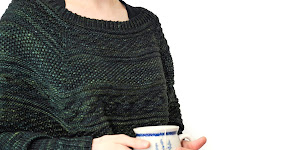Anyway. What I'm supposed to show you is this:
It's a slouchy tam to match the Triangles cowl. I wanted to knit my paternal grandmother a hat this Christmas. She taught me how to knit when I was 7 or 8, those long, skinny, striped garter-stitch scarves that I never quite figured out how to cast off and finish... She kept them in a pleather trunk by the television, where I was to leave them before I went home, but was always welcomed to pick up again on our next visit... She looks beautiful in deep, bluish reds, so I dug through my stash and was really pleased to find two skeins of Louisa Harding Kashmir DK.
If you'd like to knit your own, I'm happy to share what I did!
Triangles Tam
EDIT MARCH 2014:
**I see that the hat tuned out too large for some knitters. I've recently knit my third Triangles Tam and it really is very loose-fitting. Please consider using fingering weight and size US 4 needles rather than my recommended DK weight with US 6 for a closer-fitting hat.**
EDIT MARCH 2014:
**I see that the hat tuned out too large for some knitters. I've recently knit my third Triangles Tam and it really is very loose-fitting. Please consider using fingering weight and size US 4 needles rather than my recommended DK weight with US 6 for a closer-fitting hat.**
Materials:
-
US 4 DPNsUS 2-3 DPNs or circular needles for ribbed band. -
US 5 or US 6US 4 DPNs or circular needles for the body of the hat - 1.5 skeins (I used well under 2 skeins) of Louisa Harding Kashmir DK, or any other
DK yarnfingering weight yarn that gives you a gauge of 22 stitches over 4” with a US 6 needle.
Mini triangles chart:
Using size US 3 or US 4 DPNs or a 16” circular needle (or longer, if using magic loop method), cast on 112 stitches. Join to knit in the round.
Place marker to indicate start of row.
Work in 2x2 rib for approximately ¾ of an inch, or 7 rows.
Change size
Row 1: *Purl one stitch, purl in front and back of next stich. Repeat from * until the end of row. This is fiddly, it’s true, but you’ll only need to do it for this row, I promise!
(Here’s a good video on how to do the purl in front and back move: http://www.youtube.com/watch?v=sPJCawekDfY)
You now have 168 stitches, which appears like a regular purled row.
(Here’s a good video on how to do the purl in front and back move: http://www.youtube.com/watch?v=sPJCawekDfY)
You now have 168 stitches, which appears like a regular purled row.
Row2: Begin working from 2nd row of triangle chart. (Chart reads from right to left each row.) Repeat these 6 stitches from row 2 of triangle chart until the end of row.
Rows 3-7: Work according to chart.
Now work the entire 7-row triangle chart 3 more times.
You now have completed 4 repeats of little triangles.
Next row (decrease row): Purl 11 stitches. For the 12th stitch, work a double decrease: [slip 2 stitches from the LH needle to the RH needle as if to purl. Purl the next stitch on the LH needle. With the LH needle, bring both slipped stitches together over the purled stitch off the RH needle]. Repeat these 12 stitches to the end of row.
Work rows 2 – 7 of triangle chart.
Next row: Purl 9 stitches. For the 10th stitch, work a double decrease as described above.
Work rows 2 – 7 of triangle chart.
Next row: Purl 7 stitches. For the 8th stitch, work a double decrease as described above.
Work rows 2 – 7 of triangle chart.
Next row: Purl 5 stitches. For the 6th stitch, work a double decrease as described above.
Work rows 2 – 7 of triangle chart.
Next row: *Purl 2 stitches, work a double decrease. Repeat from * until the last two stitches, purl 2.
Next row: *Purl 1, work a double decrease. Repeat from * until end of row.
Next row: Repeat as above until last stitch, purl 1. Break yarn and thread it through the remaining stitches. Pull gently to close hole, and weave in end.










.jpg)


